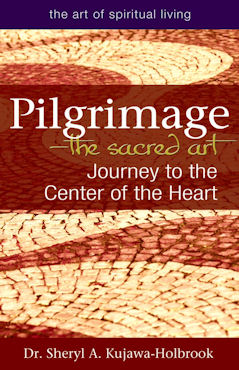
|
Posted July 19, 2013
Book: Pilgrimage: The Sacred Art: Journey to the Center of the Heart Author: Dr. Sheryl A. Kujawa-Holbrook Skylight Paths. Woodstock, Vermont. 2013. Pp. 219 An Excerpt from the Jacket:
Pilgrimage is a spiritual practice of nearly every major religion of the world. If you are a Christian you may travel to sites associate with the life of Jesus; Jews might visit the Western Wall in the Old City of Jerusalem and other sacred places in the Holy Land of Israel; Muslims participate in the Hajj, the journey to Mecca; Buddhists visit the sacred sites related to the life of Buddha. Even if you practice no religion at all you will still find that you most likely participate in this practice --- the Jefferson Memorial in Washington, D.C. and Lenin's tomb in Moscow are considered national pilgrimage sites. As a spiritual practice, pilgrimage transcends religious, national, cultural and linguistic boundaries. This fascinating look at the sacred art of pilgrimage integrates spirituality, practice, spiritual formation, psychology, world religions and historical resources. It examines how the world's religious pilgrimages evolved as central spiritual practices and the relationship between pilgrimage and transformation. It explains what makes a place holy, and why and how some sites are so compelling that they attract thousands, even millions of pilgrims each year. An Excerpt from the Book: The Need to Belong Pastor and scholar Eugene Peterson writes that we "live much of our lives in exile, so to be able to spot the people and places that re-establish our true identity is so important." The need to return home is an instinct shared between human beings and other living creatures. Every winter millions of monarach butterflies make the journey from as far away as eastern Canada to the Santuario de la Mariposa, Monarca, or the Monarch Butterfly reserve in Michoacan, located about one hundred miles north of Mexico City. Here the butterflies come to spend the winter, hunched together in the cruciform branches of the sacred oyamel fir tree. Some of these courageous butterflies travel almost two thousand miles, forming orange and black clouds on the way, and risking their lives to return. Each individual butterfly sets forth on the journey alone, and although they are seemingly delicate creatures, their collective weight bends the trees as they cling there, protected by each other from the cold. When spring arrives, the butterflies make their way north once again. Scientists have studied this pilgrimage of the monarch butterfly, but little is known about how they actually navigate the route to Mexico each year. They may navigate by solar compass or by magnetic field, and yet the inherited wisdom and power within each of these tiny creatures continues t oelude the understanding of humankind. Their sense of purpose and endurance, and their will to emulate. Not only are these butterflies important symbols of the wonders of the natural world, they have become, throughout the ages important symbols of the cycle of all life. As they grow from egg to caterpillar to pupa and then are finally transformed into butterflies, they symbolize the cycle of life, death, and resurrection or rebirth. Their story is an illustration of the importance of the journey home and the importance of a sense of belonging that instills wisdom and resilience. Dutch priest and spiritual writer Henri Nouwen writes, "Loneliness is one of the most universal sources of human suffering today." When we consider the pilgrim's journey home, it is important to note that home is more than the place we live in. in the spiritual sense, our journey home is about returning to a place of belonging. "Knowing is a road," writes Canadian poet Anne Carson. One common definition of spirituality is a deep sense of meaning and purpose with a sense of belonging that promotes integration, acceptance, and wholeness. The major religious traditions of the world all stress the need for human beings to create places where they can thrive, where they feel accepted for who they are and welcomed unconditionally. Table of Contents: 1. Journeys Across Traditions and Cultures Pilgrimage across cultures and religions The Hindu tradition The Buddhist tradition The Greek and Roman traditions The Abrahamic traditions Secular pilgrimage Virtual pilgrimage 2. The Way of the Heart Pilgrim narratives Jung and images of pilgrimage The stages of pilgrimage Spirituality of the heart 3. Holy Places, Sacred Spaces Sacred landscapes Memory places Quiet places Divine activity places Commercialization and environmental impact 4. Walking the Labyrinth A single path Origins of the labyrinth The labyrinth of Chartres Cathedral Walking as spiritual practice 5. The Journey Home The need to belong Home and pilgrimage Stories of the journey home 6. Preparing to Practice Beginning spiritual practice The practice of prayer and meditation Spiritual practices in preparing for pilgrimage Practical advice for planning a pilgrimage Guidelines for visiting Holy Places and Sacred Spaces The benefits of group pilgrimages Keeping a record of your pilgrimage Walking the labyrinth Returning home |
|
